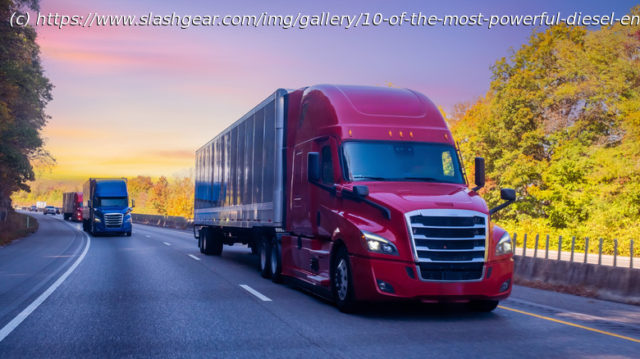These hulking diesel engines power the economy with massive torque, hundreds of horsepower, and hard-driving reliability.
Trucks are the backbone of the modern global economy, traversing the world’s longest highways. In America, semi-rigs are a familiar sight on the interstate networks, hauling tens of thousands of tons of cargo, but have you ever wondered where they get their power from?
You might be surprised to learn that there aren’t that many engines that power semi-trucks, especially the larger ones. Most of them will choose a chassis from a maker like Kenworth, Peterbilt, Freightliner, or Mack and then install a diesel engine of their choice. Major engine makers include Paccar (Kenworth & Peterbilt), Volvo, Mack, Cummins, and Detroit. There really aren’t any other major manufacturers who make semi-truck engines, so the names above will make up the majority, if not the entirety of this list. Also, we have included big names from Europe, Asia, and Australia, as their trucking industries almost rival ours, and they’ve got some amazing offerings as well.
Now, semi-trucks have two main metrics with which we judge their power — horsepower and torque. We’ve already ranked the 12 most powerful semi-truck engines by torque, so now we’ll cover the 10 most powerful semi-truck diesel engines in terms of horsepower. Note: Sport trucks like the Volvo Iron Knight with 2400 HP are exceedingly cool, but for our article, the engines have to be stock, production variants with no aftermarket tuning or modules.Mack MP8 — 505 HP
Let’s start with the old faithful workhorse, the Mack MP8. Even though it is the least powerful engine on our list, it still makes a very respectable 505 horsepower, and churns out 1,860 lb-ft of torque to boot. The MP8 engine can be optioned on every single heavy duty Mack branded truck, from day cab and sleeper semi-trucks to garbage rigs and specialist construction units. One other engine that competes with the Mack MP8 is the DD15 from Detroit Diesel engines, which also makes exactly 505 horsepower, but less torque, at 1,850 lb-ft. Mack, who recently made changes to their fan-favorite bulldog hood ornament, say that the newest generation MP 8s are 88 pounds lighter, and consequently, have 5% better MPG when running in automatic mode. In addition, to comply with the ever-more-stringent EPA laws, Mack has made some changes to their diesel exhaust fluid (DEF) aftertreatment system (AT).
One of the main updates to the DEF has major implications for cold-weather operators. DEF is about two-thirds water by volume, and water freezes up and clogs the system in cold weather. The aftertreatment system in the Mack MP8 solves this issue by moving all the DEF back into the tanks once you turn the engine off, which keeps the system lines clear, and the DEF can freeze in its tank without disrupting anything else.Paccar MX-13 — 510 HP
The MX-13 is built by Paccar for the sister brands Kenworth and Peterbilt, and will be found in iconic semi-trucks like the T680, 880, and W990 from Kenworth, and also in the 567, 579, and 589 from Peterbilt. For years, Kenworth and Peterbilt trucks have offered the Cummins X15 diesel engine, but a while ago, Paccar began making the MX-13 and mating it to the Peterbilt and Kenworth lineups. Since then, the MX-13 has been the standard option on all the Peterbilt and Kenworth heavy-haulers, though it’s worth noting that the many trucks still use the Cummins X15 engine, which is available as an optional upgrade. The MX-13 comes with 1,850 lb of maximum torque — the same as the Detroit DD15 — and makes 510 brake horsepower from a 12.9-liter displacement inline-six cylinder engine.
Paccar has said that all new MX-13 engine units that are manufactured will now be compliant with the stricter EURO 6 emissions standard, and will come with a new catalytic converter system. In addition to that, the MX-13 now has an upgraded soot filtration system as standard across the range, and will limit how often recirculated exhaust gas will be released from the engine. Detroit DD13 — 525 HP
Next up is the 12.8-liter DD13 straight-six engine that somehow manages to put out 1,850 lb-ft of torque and up to 525 peak horsepower. You’ll find this engine on rigs like the fourth and fifth-generation Freightliner Cascadia, and the Western Star 47, 49, and 57-series semi-trucks. It is a class eight diesel engine with a fixed-geometry turbocharger, and has been significantly redesigned for the latest generation with additions like swirl pistons, front-and-rear engine power takeoff (FEPTO & REPTO), and a new aftertreatment system. It also gets a new 10-pin injector system that is capable of asymmetric injection, which in turn reduces regeneration cycles on the engine, greatly increasing the DD13’s durability. All of these changes supposedly bring about an MPG improvement of about 4%, Detroit claims, though real-world data isn’t in yet.
Depending on your needs, you should be able to configure your DD13 to be EPA, CARB, OBD, and/ or GHG compliant; though if you’re looking at the M2 112 plus from Freightliner, you won’t be able to spec a CARB-compliant DD13.






